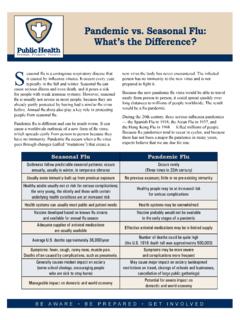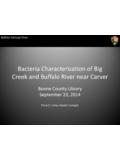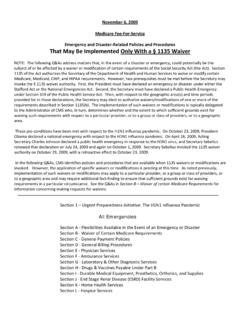Transcription of Status of Vaccine Research and Development of …
1 1 Status of Vaccine Research and Development of Universal influenza Vaccine Prepared for WHO PD-VAC I. About the Disease and Pathogen Basic information on pathogen, including transmission, estimated global disease burden for those at risk, for morbidity and for mortality, including uncertainties/data gaps, geographical distribution, economic burden if available, age groups affected and target groups for vaccination. Existing preventive, diagnostic and treatment measures and their limitations. influenza viruses are one of the major infectious disease threats to the human population owing to both the health impact of annual influenza and the tremendous global consequences of influenza pandemics.
2 Seasonal influenza alone causes 250,000 to 500,000 deaths and three to five million cases of severe illness worldwide each year [1]. A public health concern is that a highly virulent influenza strain could lead to millions of deaths in today s highly interconnected world. The recent 2009 influenza A/H1N1 pandemic illustrated the unpredictability of the influenza virus and the challenges to mounting a global response against a newly recognized virus strain. Human influenza viruses are members of the Orthomyxoviridae family and are classified into three types, A, B, and C, based on internal proteins which are highly conserved across all sub-types and strains of a particular influenza type; matrix protein 1(M1), nucleoprotein (NP) and membrane matrix protein M2.
3 Type A influenza viruses are further divided into subtypes based on the antigenicity of the hemagglutinin (H or HA) and neuraminidase (N or NA) surface glycoproteins. Currently, 16 HA and 9 NA subtypes are known, all of which exist in aquatic birds that are their natural reservoirs. influenza B viruses infect only humans but two antigenically and phylogenetically distinct lineages co-circulate. Major outbreaks of human influenza are associated with influenza A or B. The virus depends on sialic acid receptors on the host tissue, which allow attachment of viral HA proteins and cell entry. NA acts as a cleaving enzyme, ensuring release of the virus from the cell, and the Development of the infection.
4 The presence and anatomical location of different types of sialic acid receptors vary between humans, birds and other animals, accounting for the tropism of influenza A [2]. The virus circulates worldwide, with a seasonal nature that is often hemisphere-specific and mostly observed in temperate climates. Existing methods of Vaccine selection, production and distribution are best suited for seasonal nature of influenza and not well suited for preventing influenza in tropical countries where the virus circulates year-round. Therefore low-resource countries are mostly unprotected against seasonal influenza and are particularly vulnerable to future pandemics because individuals may be more susceptible to severe outcomes from influenza due to underlying nutritional deficiencies and concomitant illness, poor access to healthcare, and the lack of widespread Vaccine use against Streptococcus pneumoniae and Haemophilus influenzae Type b.
5 Additionally, many low-resource countries do not have a full picture of their influenza disease burden due to limited surveillance, and further information is becoming available only recently [3]. influenza affects all age groups but the highest risk of complications occur among young children (under 2 years), older adults (65 years and over), pregnant women, and those with certain medical conditions, such as chronic heart, lung, kidney, liver, blood or metabolic diseases (such as diabetes), or weakened immune systems. The economic cost can also be very high as a severe epidemic may affect a significant part of the working population, affecting productivity and overwhelming public health systems.
6 Anti-viral drugs specific ones such as neuraminidase inhibitors oseltamivir and zanamivir, or M2 inhibitors such as amantadine and non-specific ones such as arbidol (used in only few countries)- appear to have a limited benefit as they need to be administered early in the infection and tend to provide only some reduction in the duration and perhaps severity of symptoms of influenza . In addition, some strains of 2 influenza have developed anti-drug resistance. Vaccination remains the primary approach for controlling influenza in persons and populations. In reality the challenge of immunizing entire populations on an annual basis is currently beyond the capacities of most countries, driving the need to develop improved influenza vaccines that would offer both broad-spectrum and long-lasting protection to the populations most vulnerable to the consequences of influenza .
7 II. Overview of Current Efforts A. EITHER Vaccines currently available and their limitations OR Biological feasibility for Vaccine Development Include perceived limitations with available vaccines for low and middle income country markets (LMIC). These could include safety, effectiveness, serotype/strain coverage, supply, affordability, financing, number of WHO prequalified vaccines, WHO policy recommendations for available vaccines, perceived lack of priority from endemic country authorities. Where there are no vaccines available, this section should focus on the evidence that Vaccine Development is biologically feasible including from Development of naturally acquired immunity, from Vaccine Development for related pathogens, from animal models or in vitro data Several types of vaccines against influenza have been licensed and in long-time use around the world.
8 They range from inactivated vaccines made of killed virus and administered parenterally to live attenuated (LAIVs) made from weakened virus and administered intranasally. Inactivated vaccines may be produced in eggs or in cultured eukaryotic cells while LAIV vaccines are produced in embryonated hen eggs. Both types of vaccines share the common goal of inducing immunity primarily to the hemagglutinin (HA) protein and possibly to the neuraminidase (NA) protein of the virus [4]. The HA-specific neutralizing antibody is a recognized correlate for immunity induced by inactivated, seasonal influenza vaccines [4]. Although the precise roles of other immune responses induced by vaccination in disease protection remain largely unknown, and no other correlates have been yet defined, LAIVs are known to induce both humoral and cellular immunity mimicking the responses derived after natural infection.
9 Other influenza vaccines have entered the market more recently. The first recombinant Vaccine based exclusively on hemagglutinin was licensed in 2013 and the first influenza Vaccine produced in mammalian cell culture also achieved licensure. Most existing influenza vaccines have an excellent safety record but their efficacy in various age groups varies significantly. For example, LAIV efficacy in young children was reported as 83% [5] but it was much less effective in the elderly [6]. Furthermore, a wide discrepancy between Vaccine efficacy and effectiveness is often reported; most recent systematic Vaccine effectiveness studies indicate that overall, influenza vaccines provide a moderate level of protection; between 50 and 60% [7].
10 While some countries (such as USA since 2010) recommends universal influenza immunization (in this context, vaccination of almost entire populations) for all individuals 6 month and older, other countries either have more limited recommendations for specific age or high-risk groups, or no recommendations at all. Current WHO SAGE recommendations include the following risk groups for influenza vaccination: pregnant women (being the highest priority), healthcare workers, children 6-59 month of age, the elderly and those with high-risk conditions. Given the epidemiology and complexity of influenza and varied efficacy afforded by different types of vaccines, greater public health benefit could be achieved by separating the use of particular vaccines to particular age groups.















